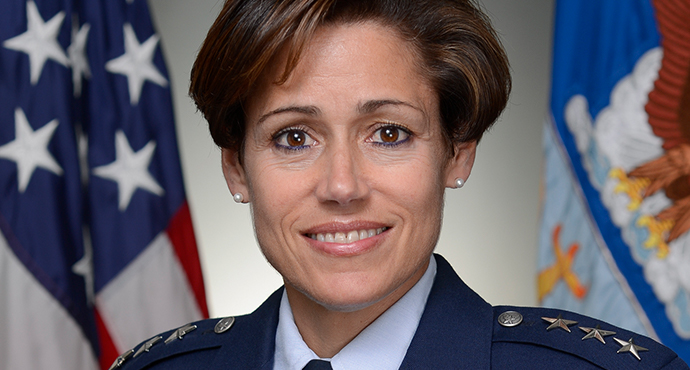
Technical workforce development: the cyber challenge.
A two-person panel offered perspectives on developing, recruiting, and retaining a cyber workforce. One represented the Air Force, the other industry; they reported similar challenges.
Lieutenant General Gina M. Grosso (Deputy Chief of Manpower, Personnel, and Services, A-1), Mike King (Vice President, Business Development, Cyber and Intelligence Mission Solutions Division, Northrop Grumman Mission Systems) were the panelists.
Air Force cyber challenges: retention, agility, and definition.
Lieutenant General Grosso described the Air Force's cyber workforce as "complex." It's roughly 80% military and 20% civilian. Since the military population is both officer and enlisted, there are effectively three distinct sets of policies and procedures involved. The challenges of managing these three populations are roughly as follows:
Officer personnel: 88% of the positions are currently filled. The biggest challenge is to retain the when their active duty commitment is up at the four-to-five year point in a junior officer's career. Retention is currently running at about 75%, and the Air Force needs around 90%. She said retention is currently under study—the Air Force doesn't yet fully understand why.
Enlisted personnel: 66% of cyber specialty positions are currently filled. Retention here is generally solid, and there's a good bit of cross-training with communications fields.
Civilian personnel: Here, the Air Force suffers from a Government-wide problem: "We lack a common definition of what a cyber position is." Grosso estimates the Air Force has about a 10% occupancy rate, "but we don't really know because of kabuki around what's a cyber job." In building the civilian workforce, she would like to have some of the authorities other agencies have that make it easier and faster to hire qualified people.
She closed her opening statement by saying that the Air Force was working on its definition of what a cyber warrior is so that it can identify the skills it needs to develop and recruit.
Industry cyber challenges: "We succeed or fail on the basis of the talent we have."
In his opening statement, King said that "cyber is built into everything Northrop Grumman does." "We succeed or fail on the basis of the talent we have," he said. "We've taken on the cyber workforce challenge with the same vigor we've shown toward developing innovative cyber solutions." He reviewed, and stressed the importance of, the well-known shortage of qualified cyber labor. He drew from this the lesson that the labor challenge must be addressed globally, and that it must be addressed with the rising generation.
King quoted a remark by General Touhil, newly appointed Federal CISO, to the effect that the jobs that will be important in five years don't exist today. This realization has led Northrop Grumman to "open its aperture" to look at people from non-traditional backgrounds, especially non-traditional academic backgrounds. (Some of their most successful analysts, he noted, have academic backgrounds in fields like history and psychology.)
King took understandable pride in Northrop Grumman's sponsorship of CyberPatriot, which he characterized as "wildly popular" in high schools and middle schools. The company has awarded more than $300k in scholarships to CyberPatriot winners, and has taken on about two-hundred high school students as interns. He commended CyberPatriot as an excellent model of workforce development. "It succeeds because it's fun—the students really enjoy it." CyberPatriot drives not only technical skills, but leadership, communication, teamwork, and ethics. It's now being pushed down to the elementary school level.
Discussion: a need for flexibility in cyber personnel and force structure.
Many personnel policies, Lieutenant General Grosso said, date back to the Cold War or even the Second World War. She would like in particular to be able to modify the up-or-out system at need. She believes in the total force—the best lateral entry into the active force is from the Guard or Reserve.
King said that Northrop Grumman brings in a lot of cyber personnel mid-career (particularly from the military). He'd like to see more sharing and internship programs between Government and industry.
To a question about the large percentage of young people in the US who are found unfit for military service on various grounds, commonly physical, Grasso thought that many standards should be "relooked" because the Air Force needs to access more of the talent in the country. "But this makes a lot of people uncomfortable," she said. "We need to rethink, frankly, weight. Do we really care what someone weighs if they're going to be a cyber warrior?" The Air Force also has a program in place now to help enlistees and future officers meet physical standards. In some ways, she thinks the Service's culture is more rigid than the personnel system itself.
On retention, King described Northrop Grumman's efforts to maintain awareness of open positions and to structure them in such a way that they're able to fill them internally in ways that meet people's lifestyle needs and aspirations.
Grosso stressed that the key to retention is knowing why people leave. The A-1 thinks that squadron-level leadership is the number one issue for enlisted personnel. For officers it's additional duties. And the tempo is always a challenge for everyone: at some point people get worn out.
Compensation is an issue for both the Air Force and, interestingly, the defense industry. Both rely on psychological compensation, but both realize that you can't set aside monetary compensation. Everyone wants enough money to take care of their family
They closed by describing their biggest worries. King said that what scared him the most is the expected 2019 industry-wide shortfall of 1.5 million workers. Grosso is concerned about agility—she'd like less regulation and a greater willingness to take advantage of all the talent that's out there.
